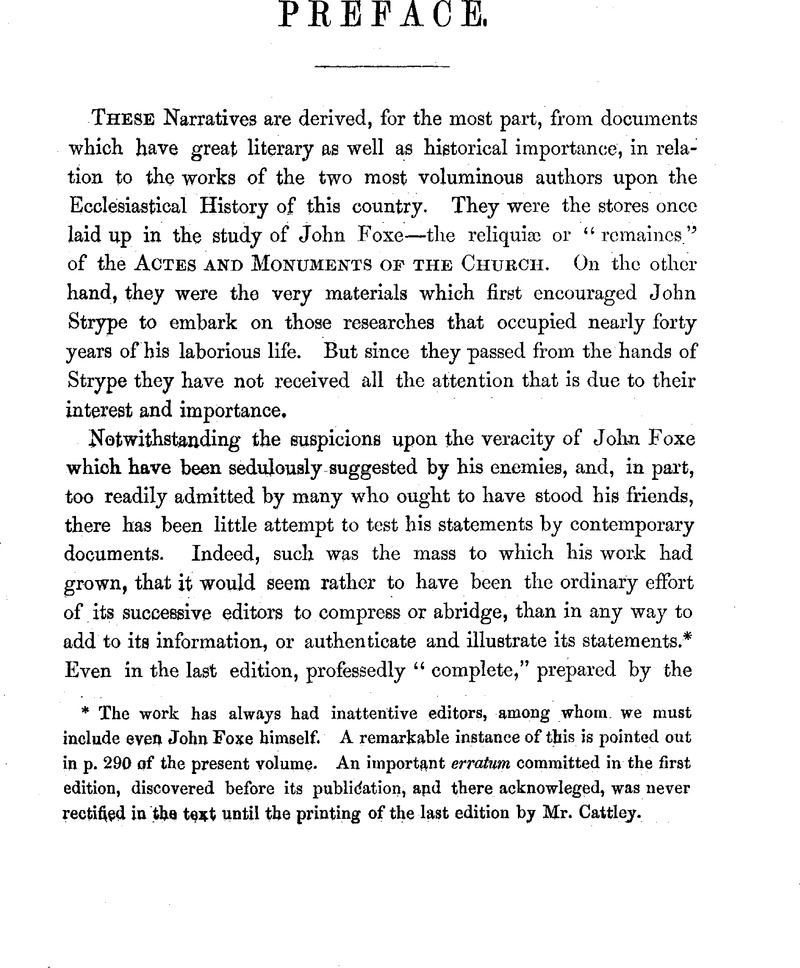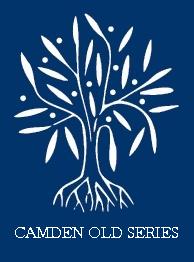No CrossRef data available.
Article contents
Preface
Published online by Cambridge University Press: 23 February 2010
Abstract

- Type
- Preface
- Information
- Copyright
- Copyright © Royal Historical Society 1859
References
page xi note * The work has always had inattentive editors, among whom we must include even John Foxe himself. A remarkable instance of this is pointed out in p. 290 of the present volume. An important erratum committed in the first edition, discovered before its publication, and there acknowleged, was never rectified in the text until the printing of the last edition by Mr. Cattley.
page xii note † John and Roger Hall to John Foxe: [their] information of one Day, a priest, curate of Maydston. In Mr. Townsend's Life, 1841, p. 149; 1843, p. 94; from MS. Harl. 416, fol. 123.
Morice's paper concerning the communication of Latimer with Bayneham when in Newgate. In vol. iv. p. 770, of the 1843–19 edition ; but not in that of 1841, as I have incorrectly stated in p. 237 hereafter.
These are all, or nearly so.
page xiii note * Nichols's Literary Anecdotes of the Eighteenth Century, vol. v. p. 360.
page xiv note * That printed in pp. 218–233 of the present volume.
page xiv note † Printed in pp. 279–286.
page xv note * Sir Thomas Willys and Sir Richard Willys, two brothers, were both created Baronets by Charles the First, the former in 1641 and the latter in 1646. Sir Richard married Alice, daughter and sole heir of Thomas Fox, M.D. who had issue an only son, Sir Thomas Fox Willys, on whose death the baronetcy conferred on his father became extinct in 1701. Of the other family there were six Baronets, the last of whom died in 1732. William Willys, esquire, of Hackney, to whom Strype was indebted for the use of Foxe's manuscripts, was a Hamburgh merchant, a younger son of Sir Thomas, the first Baronet of Fen Ditton, co. Cambridge, and consequently cousin to Sir Thomas Fox Willys. He died in 1726. (Courthope's Extinct Baronetage, 8vo. 1835, p. 216.)
page xv note † They are described at considerable length in the Catalogue of the Harleian Manuscripts, vol. i. pp. 236–250. Their arrangement, however, both as respects subjects and dates, is as confused as it could possibly be: no trouble whatever, in that respect, had been taken when they were bound.
page xvi note * It is in this volume that the narrative of William Maldon occurs, which, having been observed too late for the text of this volume, is placed at the end of the Appendix. There is a remarkable passage at its commencement, showing Foxe's habits in soliciting materials for his work. In the same volume is also preserved a contemporary narrative (but imperfect) of the murder of the Hartgills by Charles Lord Stourton: this is introduced by Strype, but with several errors, in his Ecclesiastical Memorials, vol. iii. and is reprinted by Sir E. C. Hoare in his Modern Wiltshire, Hundred of Mere, p. 153.
page xvi note † Octavo, pp. 15, dated Gloucester, Feb. 22, 1858.
page xvii note * The price of the Oxford edition, in 27 vols. (including the General Index) is now reduced from 14Z. to 11. 13s.
page xvii note † There have been two modern attempts to republish Strype, the Memorials of Cranmer having been edited anonymously for the Ecclesiastical History Society in 1848, and by Philip Edward Barnes, esq. B.A. for Mr. Koutledge, in 1853. On both occasions it was proposed that Strype's other works should follow, but no more made their appearance. Indeed, the Ecclesiastical History Society broke down after having published only two volumes out of three.
* The history of Foxe's Actes and Monuments affords an example, among scores of others. That work, and the various editions of it which appeared during the reign of Elizabeth, form a subject which is treated of by Strype in some half-dozen different places.
† “I do not mean to reflect on Strype, whose integrity and good faith are beyond all doubt: but to the question whether the documents and extracts, as they stand in his works, are in fact accurate copies of their originals, only one answer can be given. They are NOT In many cases,—and sometimes in documents of great importance, whereof one would desire to have correct copies,—:there is, as the words now stand, nothing but obvious rionsense.” (Notes on Strype, by the Rev. S. R. Maitland, D.D. p. 6.)
page xix note * Among the letters transcribed in Foxe's copy-book, which is now bound up in the Harl. MS. 417, at fol. 102 v. is the following, which is attributed to John Aylmer, bishop of London, in a side-note written by Strype; but I think it much more probable that it was written by our friend John Louthe, the archdeacon of Nottingham:—
Strype has introduced this letter in his Life of Bishop Aylmer, p. 43, (Oxford edition, p. 24,) and assigned it to about the year 1578. If the bishop of London addressed the martyrologist in these terms, they are certainly very extraordinary proof of the high estimation in which he was held by a prelate in so eminent a position; but I am inclined rather to think that they came from the enthusiastic and highly intolerant John Louthe—who yet did not choose to appear exactly in propria persona, but signed JOHANNES LOUD, not LOND. as printed by Strype, and as it had been before by Foxe (see p. 14).
page xxvii note * See in p. 17, note, his own admission, “Although I deny not,” † I am not myself aware of any proved instance of this; but it is thus stated, and judiciously commented upon, by Granger, in his Biographical History of England: “The same has-been said of Foxe which was afterwards said of Burnet; that several persons furnished him with accounts of pretended facts, with a view of ruining the credit of his whole performance. But the author does not stand in need of this apology; as it was impossible in human nature to avoid many errors in so voluminous a work, a great part of which consists of anecdotes.”
page xxvii note ‡ A Review of Fox's History of the Waldenses. 1837. 8vo.
Six Letters on Fox's Actes and Monuments. 1837.
Six more Letters. 1841.
Notes on the contributions of the Rev. George Townsend to the new edition of Fox's Martyrology: Part 1. On the memoir of Fox ascribed, to his Son; Part 2. Puritan Thaumaturgy ; Part 3. Historical authority of Fox. 1842. 8vo.
Essays on subjects connected with the Reformation in England. Reprinted, with additions, from the British Magazine. 1849. 8vo.
page xxiv note * This appears in his dedication addressed to Queen Elizabeth, in which he apologises that “the story being written in the popular tongue serveth not so greatly for your own peculiar reading, nor for such as be learned;” and again in his letter sent with a copy of the first edition to the President and Fellows of Magdalen College, Oxford:—“Hoc unum dolet, Latine non esse scriptum opus, quo vel ad plures emanare fructus historia, vel vobis jucundior ejus posset lectio. Atque equidem hoc multo maluissem, sed hue me adegit communis patrise ac multitudinis sedificandse respectus, cui et vos ipsos id idem redonare sequum est.” We have also Foxe's own statement that the translation of his Latin book into English was not made by himself, but executed by others whilst he was occupied in further researches into episcopal registers.
page xxiv note † The title of “Actes and Monuments” appears to have been borrowed from the book entitled Actiones et Monimewta Mariyrum, printed by Jean Crespin, at Geneva, in 1560. Grindal, to whom Foxe was chiefly indebted for the materials relating to the Marian persecution, speaks in his letter to Foxe dated Strasburgh, 19 Dec. 1558, of their projected work as Historia Martyrvm. It is therefore contrary to what might have been expected that the word Martyrs did not appear on the English title-page. But, although it did not, there are many proofs that the work was from a very early time recognised as The Book of Martyrs. It is so called by Thackbam at p. 93 of the present volume, and by Deighton in p. 69. Archdeacon Louthe, in p. 15, styles it “the booke of Actes and Monumentes of Martyres.” When directed to be placed in cathedral churches, “Monumenta Martyrum,”
page xxv note * Foxe himself looked forward to this sort of personal interest that would be taken in his work—“Neque non juvabit et illud nostrorum fortasse animos' quum multi in his historise monumentis suos reperient, alii parentes, alii fijios, jionnulli uxores, pars raaritos, quidam cognatos aut afBnes, plurimi vicinos aut micos: de quibus hie legere aliquid, velutique loquentes audire, pro suo quisque affectu avebit.” (Dedication of the Commentarii to the Duke of Norfolk, dated at Basle, September 1, 1559.) And yet he seems to have expected that all his readers should understand Latin.
page xxv note † In how different a position, unfortunately for literary and biographical research, are the records of the two archiepiscopal courts at present placed! While those of the province of York have been liberally thrown open, and to a certain extent made public by the aid of the Surtees Society, those of the province of Canterbury, by the arrangements of the new Courts of Probate and Divorce, have become more rigidly closed than ever. No other copies or notes are permitted than those which are made by the official scribes, and are officially authenticated. Above a certain date, when the handwriting becomes especiallyplain and legible, and free from the pothooks and hangers of modern legal penmanship, the fees for transcription are unreasonably doubled, as if in especial despite to historical inquiry. It will scarcely be credited that the brief will of John Petit, which occupies fourteen lines of the present volume, cost, with the formal record of probate (for we must take the husk with the kernel), the sum of five shillings. At the recent change of the Ecclesiastical Courts a great opportunity for the propagation of historical knowledge was suffered to pass by. The proper course would have been to have relieved the Will Office by removing its records of a date anterior to the year 1700, to the Public Becord Office, or to the British Museum. Can it not still be arranged that literary inquirers should be allowed to take unavtheriticated copies or extracts, when furnished for that purpose with a certificate from H. M. Keeper of Public Records ? Some such concession may, perhaps, yet be made, when the new buildings of the Prerogative Office are completed.
page xxvii note * Morice's paper was communicated by archbishop Parker to Foxe before the preparation of his second edition in 1570, (not 1576, as misdated in p. 234,) in the Index to which the reader's particular attention is directed to it by the following singular entry:—
“Thomas Cranmer made Archbyshop of Canterbury 1200. His storye is worthe the reading, and begynneth 2032.”
It lasts from that page to p. 2072.


